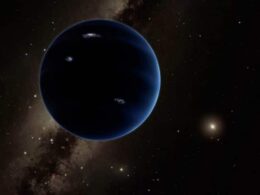Start at dusk, as soon as the sky gets dark, to catch the gas giants Jupiter and Saturn, low in the southwestern sky. Jupiter is the brighter of the pair, shining at magnitude -2. Saturn, a few degrees to its east, is fainter, resembling a bright star at magnitude -0.6. Of course, you will not see the famous rings with the unaided eye. You will need to observe with a telescope.
Jupiter and Saturn will all be easier to see for people watching from the southern hemisphere because the ecliptic – the general path along which the planets track – is currently at a steeper angle to the horizon from there, and so they will appear higher in the sky.
Both planets, incidentally, are in Sagittarius, and so are as far south in the sky as they can get. They are also closing together over the next few weeks.
Those who mourn the loss of Pluto as a planet, following its demotion by the International Astronomical Union in 2006, may like to know that it currently also lies close to Jupiter. However, you would need a powerful telescope to spot it, particularly so low in the sky.
Our next planet, Mars, also becomes visible as soon as the sky darkens, but over in the east in the constellation of Pisces. Mars is Earth’s outer neighbour in the Solar System, and it is shining particularly brightly at the moment at magnitude -2. This is because it is on the same side of the Sun as the Earth, and so is particularly close. The planet was at opposition last month.
The two outermost planets, ice giants Uranus and Neptune, can both be observed in a dark sky at the moment. Uranus is currently in the constellation of Aries, shining at magnitude 5.7 close to the theoretical limit of naked-eye visibility under pristine dark skies. It was at opposition in late October, so is visible for most of the night, and will be highest in the sky in late evening.
Again a pair of binoculars will bring Uranus into view quite easily, providing you know just where to look. Our special guide will help you to find Uranus.
The outer ice giant, Neptune, lies in the constellation of Aquarius, which is the next zodiacal constellation to the west of Pisces. You will need binoculars at least to see Neptune, because it shines at a dim magnitude 7.9. See our special guide to help you to find Neptune for yourself.
We have to wait until much later in the night to see our next planet, Venus, which rises around three hours before the Sun. But it is much easier to spot – in fact, at a brilliant magnitude of -4, you can’t miss it! Venus lies in the constellation of Virgo at present.
Finally, as the sky brightens with pre-dawn twilight, look out for the innermost planet, Mercury, in the southeast, several degrees to the lower left of Venus as viewed from the northern hemisphere. Mercury, in the constellation of Virgo, is shining at magnitude -0.6 at the moment, comparable to the brightest stars, but will be dimmed by the effect of the deeper atmosphere at low altitudes. This is an effect known as extinction.
Binoculars will help you find Mercury, but you will need to look before the sky becomes too bright, and well before sunrise. Do not ever point them towards the Sun! You may be able to see Spica, the brightest star in Virgo, close by. It is about a magnitude fainter than Mercury.
If you’ve managed to see all the planets in one night, then congratulations!


